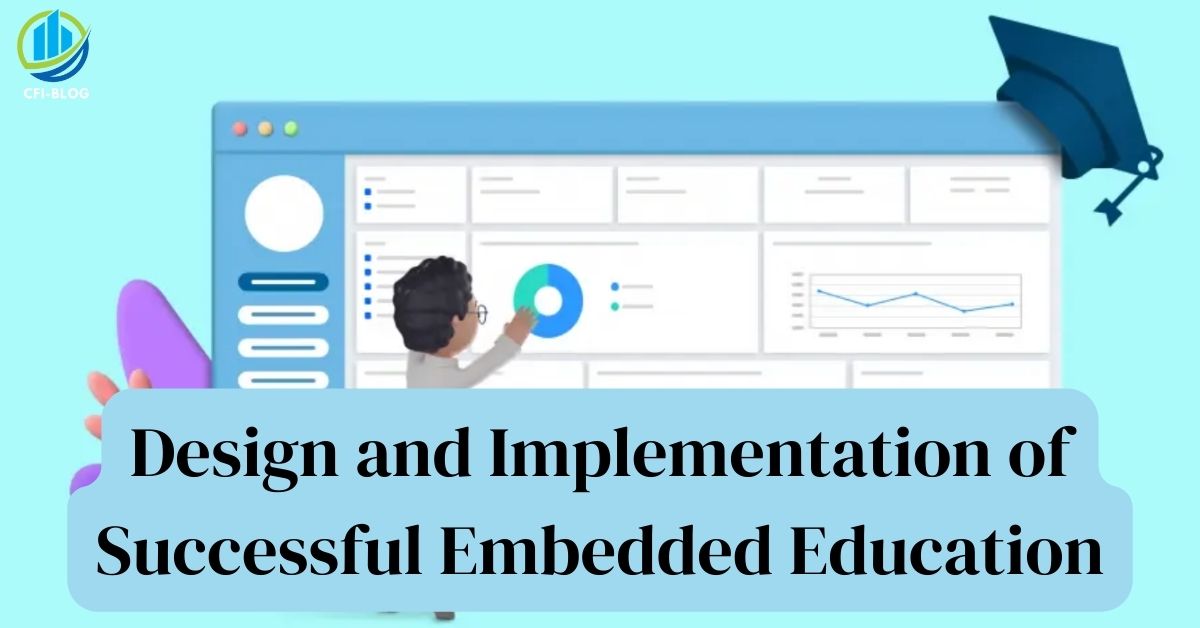Financial education is essential to our economy as well as social well-being. Financial education can be imparted in academic classrooms, through social groups, political settings, and even inter-personally. However, the traditional method through which microfinancing opportunities (MOF) are provided by FE.
Earlier and more conservative methods had the problem of scalability, as educating a large number of people requires huge capital. Consequently, the embedded education approach was adopted. This approach provides financial education at each contact point, which is presented by a financial service provider. In this article, we have provided detailed information on the embedded education approach.
What is Financial Education and Why is it Needed?
Financial education promotes the need for financial-capability development. If someone is not financially literate in their community or society, with the help of financial education, the person can learn to make and manage money better, and avoid debt traps. Financial education educates people regardless of their circumstances and income level. It especially targets low-income individuals that are living in developing countries or rural areas, and who have access to fewer resources.
In growing economies, honesty is a top priority. That’s why a new frontier in formal services honesty concept has been initiated in today’s organizations. Financial education aims to empower people to make informed financial decisions. It provides knowledge about money management, how to track spending, earning, borrowing, saving, completing basic financial documentation, etc. It guides you to obtain benefits from available financial services, both formal and informal. Ultimately, it boosts your confidence while making financial decisions and teaches you to take control of your credit on a day-to-day basis.

The first program on financial education was initiated by Microfinance Opportunities and Freedom from Hunger and named The Global Financial Education Program (GFEP). It was aimed at people in developing countries who were below or just above the poverty line. GFEP was funded by the Citi Foundation and includes a curriculum based on different wealth-management methods.
MFOs have even trained service agencies with essential skills that cater to low-income clients. It has been quite some time since. Still, the work is continuous. MFOs have worked with organizations globally to understand the ground realities at the grassroots level and update their curriculum accordingly.
Which Method Can Scale up Financial Education?
To be entirely realistic, providing financial services to an unbanked population comes with its share of problems. For instance, most blue-collar low-income individuals do not even have basic knowledge of money management; they would fall into a debt trap or would end up signing up for a service that they didn’t use.
According to MFOs research, a major problem that the individuals had was a lack of financial capabilities. To end this problem, MFO thought to expand financial education to every customer of any FSP (Financial service provider). By expanding this, consumers can get guidance on money management and avoid indebtedness. They can know about DLA Piper’s drafted legal framework to support financial inclusion and make use of it.
To expand financial education, MFOs require huge capital. To make this opportunity accessible, and spread it to a massive number of people, one needs funds. The amount of capital required maybe 10% to 15% of total MFO assets worldwide. According to a report published by The Monitor Group, the cost is estimated to be around $7 billion to $10 billion. The reason behind this huge cost is the sheer amount of infrastructure required, in order to take the traditional route, like building classrooms, allotting specific timings, etc.
So, to reduce costs, MFOs have come up with the Embedded Education approach. In this process, MFOs leverage encounters that take place through the service delivery channels, originally made for non-educational purposes. By following this approach, MFOs have saved a lot of money. They have expanded this approach in countries like Zambia, India, and the Philippines. They execute this educational service via Consumer Education for Branchless Banking programs that have been set up in these countries.
What is Embedded Education?
Embedded Financial Education functions by identifying all the teachable moments or contact points in an FSP, telecommunications service, or financial institution interaction that fulfill the requirement of being a good delivery system for financial education. In simpler terms, the organization recognizes vital interactions throughout the process of financial service delivery and embeds key money-management information in them.

MFO is the active vanguard carrying out the embedded financial education approach and keeping it updated according to consumer needs. It monitors and curates the financial content that provides knowledge to consumers. In the case of embedded education, MFOs integrate financial or monetary content into the core business procedure of the FSP without actively showcasing the educational aspect of the content externally.
With the help of this content, a consumer can make key money management decisions to come out of any rough financial situation. The consumer can even know about the impact of mission-based lending and take help from it.
Embedded Education solves the problem of scalability as it is cost-effective. MFO does not require building classrooms or hiring loads of staff. With the help of this method, important survivalist knowledge is imparted when access to finance means the difference between life and death. By employing this method, MFOs can train existing consumers and save a lot of money.
Key Strategies for Embedded Education
With regular research and innovations, MFOs have learned five key elements that are extremely essential to an excellent embedded education approach:
- Firstly, MFOs find all the consumer meeting points at which they can integrate Financial Education.
- MFOs provide business insights that are clear and concise.
- The organization should find existing channels created for non-educational purposes, that are linked with consumers, and create useful tools to deliver FE.
- Hiring staff to deliver FE to consumers in real time.
- To empower consumers and appoint the stakeholders to increase the financial capability of the consumers. With the help of embedded education, MFOs can confirm that FE is not propagated by just one contact point.
What is MFO?
MFO stands for Microfinance Opportunities. It is a non-profit organization spread out across the globe. The main hope and goal behind the creation of this organization are to educate low-income individuals with little to zero knowledge of finance. They follow the embedded education approach wherein they partner with FSP, telecommunications, or any other institutions and provide financial content through all the existing contact points of service delivery.
MFOs break down relevant financial insights into understandable pieces of information so that consumers make informed decisions when they are in a rough spot. They provide insights based on their consumer research and market analysis. With technological advancement accelerating financial inclusion with new data is the go-to strategy for an organization.
With the help of financial education tools, MFO plans on increasing the financial capabilities of each consumer. With the rapid shift from traditional money transactions to easy online transactions, Financial institutes like MFO consistently innovate and keep them up to date. They respond to the change by Creating new content consistently that can cater to consumers every time. Now with embedded education, MFO is providing financial education at a larger scale economically.
What Does MFO Do?
Microfinancing opportunities provide financial assistance to low-income individuals via FSPs or any other organizations. They provide key financial insights through all the contact points in an FSP. MFO provides technical support to these FSPs, which the consumer uses. With the contents which MFO provides, a consumer can make informed financial decisions.
MFOs aim to increase the Financial Capabilities of their Low-income Consumers and enhance their financial well-being.
MFO’s Experience with Zambia
MFO had initiated a financial education program in Zambia by partnering with Zoona and Vision fund(VF). Zoona provided a financial platform to transfer money in real via their distribution channels, and Vision Fund provided microfinancing options. Just before the program, VF changed its loan transaction method and shifted to e-payments via Zoona’s distributing channels.
Now, shifting to e-payments was tough for VF consumers, as they were habituated to the previous system. So, FE was needed here, to educate the VF consumers on e-payments, and increase their financial capabilities. Not only did FE target e-payment, but it also taught consumers how to track their savings, spending, debt management, and budgeting. This boosted VF consumers’ confidence and made them more knowledgeable about the service provided by VF.
Here’s how MFO integrated FE into the existing system. At first, MOF identified all the consumer contact points and teachable moments in the existing system. Then, MOF provided eight 20-minute FE videos that the VF staff could integrate into their monthly consumer meetings. Consumers would get illustrated workbooks to use in FE training sessions. These books would even have key money management insights that you could read at home.
There are client loan group meetings that focus mainly on the features offered by Zoona, followed by a 5 min Q&A session. Prior training was provided by MFO, to the officers working at Zoona and VF, on how to deliver FE to each consumer. They also provided tools that were simple and attractive to engage consumers in using the tool and getting financial insights. The topics included in the FE were relevant and interesting.
For consumer education, MOF provided workbooks, and colorful posters containing financial trivia. Some posters had step-by-step procedures on how to use Zoona to transfer money. Some agents even hung posters displaying important financial insights and meeting discussion topics outside their counters. The MOF aims at educating consumers daily, through each contact point, to ensure sufficient and proper financial education that was necessary for Zambian people.
Effects of MFO’s Embedded Strategy in Zambia
Due to the successful operation of MFOs embedded education strategy in Zambia, there has been a positive outcome. The reason for its success is due to the integration of FE into the FSP’s existing service. The positive effects of FE include lower delinquencies on loans and a rapid transactional process.
The FE provided by the MFOs enhanced the financial thought process and enabled them to make informed decisions. With the help of financial insights, the overall population had increased financial capabilities. By following the embedded education approach by partnering with Zoona and VF, they have saved a ton of money and increased their scale. Lastly, Clients that were using VF gained financial insights and developed multiple skills that helped them grow.
Benefits of the Embedded Approach
According to the experience in Zambia and various other projects that were conducted, it was established that the embedded approach method is the solution to scale FE at a larger scale. Embedded education methods have multiple benefits such as:
- It is cost-effective as there is no need to build infrastructure.
- It uses the existing FSP system, so it is easily accessible to consumers.
- This process does not have just one contact point to deliver FE; it has multiple. That is how it ensures that even officers and key management staff educate customers smoothly.
Frequently Asked Questions (FAQs)
Q1. What are the benefits of using embedded instruction?
Embedded instruction helps consumers learn the instruction on a day-to-day basis. The financial education content is embedded with the existing system of an FSP(Financial Service Provider); due to this, a consumer gets education at every contact point of an FSP when used.
Q2. What is the main purpose of embedded systems?
One of the main purposes of using the embedded system is as it is cost-effective. Using an embedded system solves the problem of scalability which the classroom format faces. It is impractical to scale a classroom format education. In the case of embedded systems, a consumer gets relevant and key insights about finance without going to a classroom.
Q3. What is an embedded lesson plan?
With regular research and innovations, there are five key elements that are extremely essential to an excellent embedded education approach:
- First, identify all the contact points where the content will be integrated.
- The content should be clear and concise.
- The organization should find existing channels created for non-educational purposes, that are linked with consumers, and create useful tools to deliver content.
- Hiring staff to deliver content to consumers in real time.
- With this method, the organization can ensure that content is not only delivered at one contact point.
Bottom Line
Ultimately, financial education is indispensable to financial stability and social progress, especially for low-income households with only preliminary levels of financial literacy. Financial education can provide you with knowledge on how to save money, how to track your spending, savings, etc. MOFs (Micro Financing Opportunities) is a non-profit organization that provides financial advice to consumers of FSPs (Finance Service Providers). To spread FE to a large scale, huge capital is required, prompting MOFs to use the embedded education method.
With the help of this method, monetary knowledge is provided at every key contact point, so, a consumer uses it while using an FSP. following an embedded education method is easily accessible and cost-effective as well. So, MOFs use this method. They have started this program in three countries: India, Zambia, and the Philippines so far.
Author Profile

- Jonas Taylor is a financial expert and experienced writer with a focus on finance news, accounting software, and related topics. He has a talent for explaining complex financial concepts in an accessible way and has published high-quality content in various publications. He is dedicated to delivering valuable information to readers, staying up-to-date with financial news and trends, and sharing his expertise with others.
Latest entries
 BlogOctober 30, 2023Exposing the Money Myth: Financing Real Estate Deals
BlogOctober 30, 2023Exposing the Money Myth: Financing Real Estate Deals BlogOctober 30, 2023Real Estate Success: Motivation
BlogOctober 30, 2023Real Estate Success: Motivation BlogOctober 28, 2023The Santa Claus Rally
BlogOctober 28, 2023The Santa Claus Rally BlogOctober 28, 2023Build Your Team – the Importance of Networking for Traders
BlogOctober 28, 2023Build Your Team – the Importance of Networking for Traders

